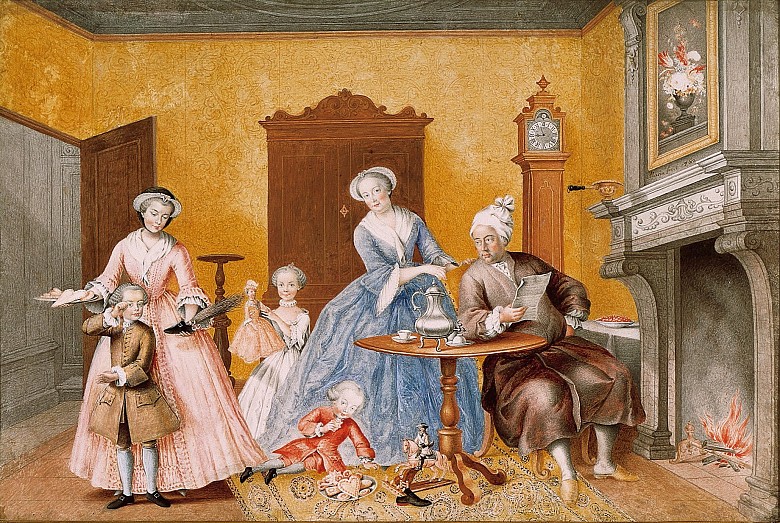Maria Theresa as wife and mother
Maria Theresa liked to present herself as a devoted wife and mother. This clichéd image has to a certain extent determined the way she has been perceived right up to the present day.
Maria Theresa, the mater familias surrounded by a cheerful brood of children, provides for the well-being of husband and offspring. Invigorated by the warm domestic atmosphere she devotes herself to the affairs of state and holds sway with a benignly maternal gaze. Thus might one summarize the image of Maria Theresa propagated in popular accounts to this day.
It is undisputed that the marriage of Maria Theresa and Franz Stephan was astonishingly harmonious. The two had known each other since childhood, and the young Maria Theresa conceived an early affection for the Lotharingian prince who was nine years her senior and who had been chosen as her future husband when she was only six.
It was a love match, and as such untypical of the aristocratic court milieu, where unions were concluded between dynasties rather than individuals. Franz Stephan called his wife Chère Mitz or Reserl, while she called him Mäusel (little mouse), as attested by their many letters to each other. They made a point of demonstrating the harmonious nature of their life together, as an account by the Prussian Grand Chancellor Baron von Fürst-Kupferberg shows: ‘Few private individuals live in such heartfelt concord as the Emperor and Empress’.
Maria Theresa’s concept of married life was occasionally derided as bourgeois by her contemporaries. Her strict interpretation of Catholic sexual morals with regard to conjugal fidelity frequently led to considerable conflict with her husband Franz Stephan, who had a very liberal attitude in this respect and few inhibitions about acting upon his desires.
Maria Theresa’s family increased rapidly and flourished. She bore sixteen children within the space of nineteen years, giving birth to her first child at twenty and her last at thirty-nine. All of these were single births.
Only ten of the sixteen children born to the imperial couple lived into adulthood. Infant mortality was generally very high, even in the imperial family, where privation was unknown and the very latest in contemporary medical care was available. Three children, a son and two daughters, died of smallpox in adolescence. Two daughters died at birth and another daughter in infancy.
This was accepted as ordained by God, for the death of infants and small children was a frequent occurrence. This attitude can also be discerned in the way the names were handed on in Maria Theresa’s family: when a child died, the next one was given the same name. Three daughters, one after the other, were baptized Maria Karolina, while two others bore the name Maria Elisabeth. It should be borne in mind that these were significant names: Karl/Karoline/Charlotte recalled the father of Maria Theresa, Charles VI, while Elisabeth commemorated the mothers of Maria Theresa and Franz Stephan, who both bore this name.
In time this large brood produced an even larger number of grandchildren: Maria Theresa became the proud grandmother of 56 grandchildren, although not all of them were to survive into adulthood.
Maria Theresa deliberately exploited her role as mother. One particularly telling example was the incident when she appeared before the Hungarian Diet with her small son Joseph, presenting herself as a young wife and mother who needed the support of the Hungarian nobility. Numerous reports compiled by ambassadors to the court contain accounts of how Maria Theresa was fond of presenting herself surrounded by her children. Marie Antoinette also told her confidantes of her mother’s calculating manner: ‘As soon as news arrived of the arrival of a foreigner of importance in Vienna, the Empress surrounded herself with her family, brought him to the table and by means of this calculated demonstration of closeness evoked the belief that she herself supervised her children’s upbringing’.
Maria Theresa was a strict mother, and her offspring in the imperial nursery were certainly not spoiled. Isabella of Parma credited her mother-in-law with loving her children, but (...) ‘her love is never free of mistrust and a noticeable coolness (...) As far as her children are concerned, the Empress does indeed love them, but she proceeds from a false precept, which consists in a strictness of all too great severity’.
The children suffered from their mother’s capricious nature; she was susceptible to flattery and often doled out her affection in a very inequitable manner, having clear favourites among her children. Maria Theresa was very free with often scathing and hurtful comments on the behaviour of her children, who were still subject to her strict control even when they had grown up and left the court. The empress saw them primarily as representatives of the dynasty who in the limelight of public life at court must always keep in mind their high birth and behave in keeping with the standards that were applied to them on account of their high-ranking social position.
This can be illustrated by an extract from the instructions in conduct sent by Maria Theresa to her daughter Maria Amalia: Your manner of speaking (...) is anything but good, especially when you are speaking French. That is not my fault; how often have I harangued you and shown you how better to make progress, but in vain (...) The less you speak the better (...) For I know the manner in which you chatter away and must tell you as a friend that it is very tedious and larded with all sorts of platitudes (...).














